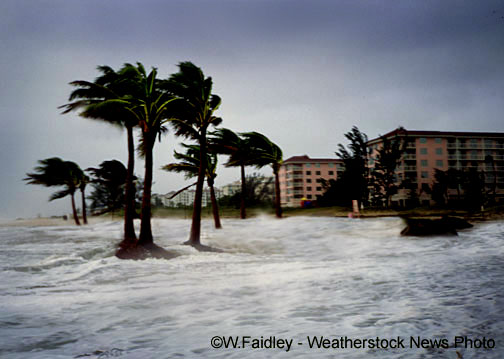
Picture Courtesy of Weatherstock News
Hurricanes
Wikipedia states that a "hurricane is a type of storm, properly called a tropical cyclone." It defines a tropical cyclone as a low-pressure system formed in the tropics. If the tropical cyclone hits populated land, then it is usually very destructive, but when it stays out at sea, it is an important part of the balance in the atmosphere because it moves heat from the equator to the higher latitudes. They will begin near the equator in the Caribbean Sea and the Gulf of Mexico.
The word "hurricane" comes from West Indian: huracan means "big wind." A hurricane can have a diameter of 450 miles and can travel hundreds of miles before it loses momentum. Hurricanes are seasonal and occur mostly in August and September.
Hurricanes begin when warm wet air masses form over the sea and begin to rise. The air, water and heat combine in a spinning system of clouds. The winds spin in a counter-clockwise direction in the northern hemisphere and a clockwise direction in the southern hemisphere. A hurricane's center is called its eye and is very calm. A hurricane will last from nine to twelve days and starts as an easterly wind. If the system is strong enough, it later develops into a tropical depression with winds up to 31 miles per hour. As it grows in strength, it develops into a tropical storm with winds up to 73 miles per hour. If it continues above that, it is called a hurricane.
Wind speeds of a hurricane range from seventy to one hundred fifty miles per hour. These winds blow circularly around a low-pressure center known as the eye of the storm. The energy of a hurricane is enough to supply an industrial plant with power for an entire year. Hurricanes cause numerous deaths in addition to the millions of dollars of property damage each year due to the intense winds and huge tidal surges. One of the most destructive elements of a hurricane is the huge waves that are formed because of the strong winds and heavy rains. These waves, called a storm surge, can rise several feet above water levels, especially during high tide.
Hurricanes rotate in a counter-clockwise direction around an eye. Hurricanes have winds at least 74 miles per hour. When they come onto land, the heavy rain, strong winds and heavy waves can damage buildings, trees and cars. The heavy waves are called a storm surge, which are very dangerous.
The winds from the hurricanes cause damage by blowing roofs off homes and buildings. Trees are blown down, sometimes taking down the electrical lines and leaving residents without power for days. The winds stir up high waves which pound along the shoreline. The ocean water floods the homes along the coast. Merrilee Hooker in her book, Disasters: Hurricanes, says that nine out of every ten deaths from hurricanes are due to high water.
During World War II, the weathermen in the military started to name hurricanes after their wives and girlfriends. Today the National Weather Service uses both male and female names and starts over in alphabetical order every year.

Picture Courtesy of
Weatherstock News
In the fall of 2004, several hurricanes hit Florida. Hurricane Charley hit the southwestern coast of Florida on August 13. It was a Category 4 hurricane, which was the strongest hurricane in the United States since Hurricane Andrew in 1992. On September 5, Hurricane Frances hit the east coast of Florida. It was a Category 2 hurricane. Then on September 26, Hurricane Jeanne hit the east coast of central Florida. The National Weather Service tracked the 2004 hurricanes on their site with this chart.
Here are some other
interesting sites for hurricanes: